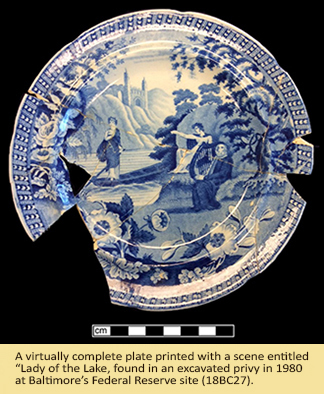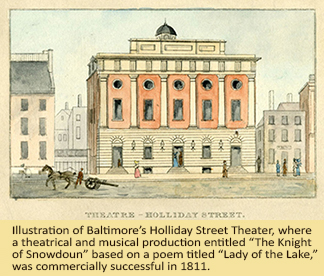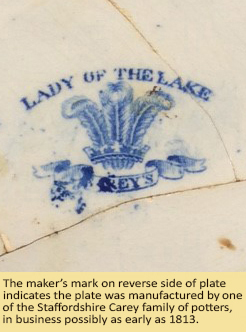Curator's Choice 2017
Pop Culture, Nineteenth-Century Style: The Lady of the Lake
March 2017
By Patricia Samford,
MAC Lab Director
 Popular culture often informs our consumer behavior, from clothing choices to household furnishings. It’s nearly impossible to walk down a city street without seeing t-shirts heralding the latest Hollywood movie. The residents of early nineteenth-century Baltimore were no different than us, using the popular culture of their day to inform their purchasing decisions. Archaeologists, who deal with the detritus of daily lives, are often witnesses to these consumer choices.
Popular culture often informs our consumer behavior, from clothing choices to household furnishings. It’s nearly impossible to walk down a city street without seeing t-shirts heralding the latest Hollywood movie. The residents of early nineteenth-century Baltimore were no different than us, using the popular culture of their day to inform their purchasing decisions. Archaeologists, who deal with the detritus of daily lives, are often witnesses to these consumer choices.
A privy excavated in 1980 at Baltimore’s Federal Reserve site (18BC27) yielded a virtually complete example of a plate printed with a scene entitled “Lady of the Lake”. A narrative poem of this name written by Sir Walter Scott was first published in 1810 (Scott 1810). Scott’s poem, a tale of chivalry set in the Scottish Highlands, enjoyed wide popularity, selling 25,000 volumes in its first eight months (Hartvigsen 2008). The plate’s design, based on drawings from the original book, depict an amalgamation of two scenes from the poem.
 Within the year, the poem was adapted by Thomas Morton into a theatrical and musical production entitled “The Knight of Snowdoun” (Hartvigsen 2008). It was commercially successful in England and the United States, appearing in New York in May of 1811 (Ireland 1866:278) and at Baltimore’s Holliday Street Theater that same year (Scharf 1881).
Within the year, the poem was adapted by Thomas Morton into a theatrical and musical production entitled “The Knight of Snowdoun” (Hartvigsen 2008). It was commercially successful in England and the United States, appearing in New York in May of 1811 (Ireland 1866:278) and at Baltimore’s Holliday Street Theater that same year (Scharf 1881).
If we delve deeper into this plate’s context, can we determine whether it was purchased from a love of literature, an appreciation of the theater, or perhaps even as a political statement? The privy where it was found was associated with the residence at 514 Sharpe Street. Robert Williams, tavern keeper, leased the lot starting at the end of the eighteenth century and continuing into the 1840s (Basalik 1994). The privy contained a high percentage of artifacts related to food preparation and serving, consistent with the property’s use as a tavern.
The plate bears a maker’s mark on its reverse, indicating that it was manufactured by one of the Staffordshire Carey family of potters, in business possibly as early as 1813 (the potteries.org 2017). In 1811, the year of the play’s Baltimore performances, our new Republic was soon to return to war with England over trade restrictions and the unwanted impressment of American sailors. Our citizens were much taken with this tale of a Scottish nobleman who rebelled against the English (Tucker 2017) and perhaps, therefore, reflected current American sentiment. The purchase of this plate, possibly even during the war itself, may have been seen as a physical reminder of patriotic feelings evoked by the poem and the play.
The tavern, located three blocks from Baltimore’s harbor, probably included sailors among its clientele. If so, the sentiment expressed by this plate may have struck a chord with them, as they risked their lives in the conflict with the British. Or the poem’s hero rebel, Roderick Dhu, may have whipped up feelings against the English.
As an interesting aside, the origins of our presidential anthem “Hail to the Chief,” lay in the “Bat Song” featured early in Scott’s poem. This song was first used as early as 1815 to honor an American president (Tucker 2017).
| References |
|
| Basalik, Kenneth |
| 1994 |
Urban Development in the Eastern United States: An Archaeological View from Baltimore, Maryland. PhD dissertation, Temple University. University Microfilms, Ann Arbor. |
|
| Hartvigsen, Kathryn |
| 2008 |
Nineteenth-Century Theatrical Adaptations of Nineteenth-Century Literature. M. A. Thesis, Brigham Young University, Provo. Website accessed January 23, 2017. http://scholarsarchive.byu.edu/cgi/viewcontent.cgi?article=2505&context=etd |
|
| Ireland, Joseph Norton |
| 1866 |
Records of the New York Stage: From 1750 to 1860, Volume 1. T. H. Morrell, New York. |
|
| Scharf, John Thomas |
| 1881 |
History of Baltimore City and County, from the Earliest Period to the Present Day. Louis Everts, Philadelphia. |
|
| Scott, Walter |
| 1810 |
The Lady of the Lake; A Poem. Edinburgh: Printed for John Ballantyne and Co. |
|
| Thepotteries.org |
| 2017 |
Thomas and John Carey and John Carey and Son. A-Z of Stoke-on-Trent Potters. Website accessed January24, 2017 at http://www.thepotteries.org/allpotters/216.htm and http://www.thepotteries.org/allpotters/215.htm. |
|
| Tucker, Abigail |
| 2017 |
Hail to the Chieftain. Smithsonian. January/February 2017:11-12. |
|